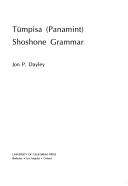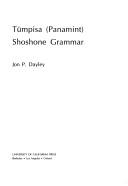| Listing 1 - 7 of 7 |
Sort by
|
Book
Year: 1972 Publisher: Berkeley (Calif.) : Center for South and Southeast Asia Studies, University of California,
Abstract | Keywords | Export | Availability | Bookmark
 Loading...
Loading...Choose an application
- Reference Manager
- EndNote
- RefWorks (Direct export to RefWorks)
Multi
ISSN: 09337636 ISBN: 9783110308631 9783110308679 3110308673 3110308630 1306091810 9781306091817 Volume: 64 Publisher: Berlin New York Mouton de Gruyter
Abstract | Keywords | Export | Availability | Bookmark
 Loading...
Loading...Choose an application
- Reference Manager
- EndNote
- RefWorks (Direct export to RefWorks)
This is the first modern grammar of Nuosu written in English. Nuosu belongs to a little known section of Tibeto-Burman. The 2.5 Million ethnic Nuosu are part of the Yi nationality and live in Sichuan (China). This grammar informs Tibeto-Burman linguists, typologists, scholars of language contact and foreign learners of Nuosu.
Sino-Tibetan languages --- Grammar --- Yi language --- Gni language --- I language --- Lolo language --- Nosu language --- Nyi language (Yi) --- Loloish languages --- Grammar. --- China --- Languages.

ISBN: 0520094670 9780520094673 Year: 1973 Volume: 75 Publisher: Berkeley (Calif.): University of California press,
Abstract | Keywords | Export | Availability | Bookmark
 Loading...
Loading...Choose an application
- Reference Manager
- EndNote
- RefWorks (Direct export to RefWorks)
Lahu language --- Tibeto-Burman languages. --- Lahu (Langue) --- Langues tibéto-birmanes --- Grammar. --- Grammaire --- Asian languages --- -Kaihsien language --- Lohei language --- Moso language (Lahu) --- Muhso language --- Musso language --- Namen language --- Loloish languages --- Grammar --- Kaihsien language --- Lahu language - Grammar
Book
ISBN: 9783110576931 3110576937 3110765802 Year: 2019 Publisher: Berlin De Gruyter Mouton
Abstract | Keywords | Export | Availability | Bookmark
 Loading...
Loading...Choose an application
- Reference Manager
- EndNote
- RefWorks (Direct export to RefWorks)
Kaduo language --- Language and languages --- Linguistics --- Gazhuo language --- Kado language (Loloish) --- Kadu language (Loloish) --- Katso language --- Kazhuo language --- Loloish languages --- Linguistic science --- Science of language --- Grammar --- Grammar, Polyglot --- Polyglot grammar --- Grammars --- Asian languages --- Khatso language

ISBN: 0520097114 9780520097117 Year: 1988 Volume: 111 Publisher: Berkeley (Calif.) : University of California press,
Abstract | Keywords | Export | Availability | Bookmark
 Loading...
Loading...Choose an application
- Reference Manager
- EndNote
- RefWorks (Direct export to RefWorks)
Sino-Tibetan languages --- English language --- Lahu language --- Lahu (Langue) --- Dictionaries --- English --- Dictionnaires anglais --- English. --- S15/1300 --- -Kaihsien language --- Lohei language --- Moso language (Lahu) --- Muhso language --- Musso language --- Namen language --- Loloish languages --- China: Language--Other languages in China --- -English --- -China: Language--Other languages in China --- Kaihsien language --- Dictionaries&delete& --- Lahu language - Dictionaries - English.
Book
ISBN: 1443852228 1299974236 9781299974234 9781443852227 1443848182 9781443848183 Year: 2013 Publisher: Cambridge Scholars Publishing
Abstract | Keywords | Export | Availability | Bookmark
 Loading...
Loading...Choose an application
- Reference Manager
- EndNote
- RefWorks (Direct export to RefWorks)
Sociolinguistics --- Chinese language --- Naxi language --- Chinese language. --- Naxi language. --- Linguistic change. --- Historical linguistics. --- Comparative linguistics. --- Comparative philology --- Philology, Comparative --- Historical linguistics --- Diachronic linguistics --- Dynamic linguistics --- Evolutionary linguistics --- Language and languages --- Language and history --- Linguistics --- Change, Linguistic --- Language change --- Lomi language --- Moso language --- Mosso language --- Na-hsi language --- Na-khi language --- Nahsi language --- Nakhi language --- Loloish languages --- Sino-Tibetan languages --- Grammar, Historical. --- History --- Language and culture --- Sociology --- Integrational linguistics (Oxford school)
Book
ISBN: 1283166011 9786613166012 311024585X 3110245841 3111871304 9783110245844 9783110245851 Year: 2011 Publisher: Berlin Boston
Abstract | Keywords | Export | Availability | Bookmark
 Loading...
Loading...Choose an application
- Reference Manager
- EndNote
- RefWorks (Direct export to RefWorks)
Dialectology proper has traditionally focused on the geographic distribution of language variation as an end in itself and has remained relatively segregated from other branches of linguistic and extra-linguistic inquiry. Cross-fertilizing winds have been blowing through the field for more than a decade, but much work remains for adequate synthesis. This book seeks to further the interdisciplinary integration of the field by highlighting, and harnessing, the many dialectic tensions inherent in language variation research and dialect definition. Undertaking a broadscale experiment in applied dialectics, the book demonstrates multiple grounds for insisting on a more robust, integrational approach to dialectology while simultaneously demonstrating grounds for defining the Phula languages of China and Vietnam. The Phula languages belong to the Burmic sub-branch of the Tibeto-Burman family and are primarily spoken in southeastern Yunnan Province, China. With origins as early as the ninth century, these language varieties have been left undefined, and largely unresearched, for hundreds of years. Based on extensive original fieldwork, the book identifies 24 synchronic Phula languages descended from three distinct macro-clades diachronically. This is accomplished by blending typological-descriptive, historical-comparative and socio-cognitive perspectives. Diagnostics include both qualitative and quantitative measurements, and insights from history, geography, ethnology, language contact, sociolinguistics and more are called on for data interpretation. This dialogic approach incorporates complexity by asserting that dialectology itself best flourishes as an interdependent dialectic - a dynamic synthesis of competing perspectives.
Anthropological linguistics - China - Yunnan Province. --- Anthropological linguistics -- China -- Yunnan Province. --- Anthropological linguistics - Vietnam. --- Anthropological linguistics -- Vietnam. --- Yi (Chinese people) - Ethnic identity. --- Yi (Chinese people) -- Ethnic identity. --- Yi (Chinese people) - Languages. --- Yi (Chinese people) -- Languages. --- Yi language - Dialectology. --- Yi language -- Dialectology. --- Yi Language - Phonology. --- Yi Language -- Phonology. --- Yi language --- Yi Language --- Yi (Chinese people) --- Anthropological linguistics --- Languages & Literatures --- East Asian Languages & Literatures --- Dialectology --- Phonology --- Languages --- Ethnic identity --- Dialectology. --- Phonology. --- Languages. --- Ethnic identity. --- Lolo (Langue d'Asie) --- Yi (Peuple de Chine) --- Ethnolinguistique --- Dialectologie --- Phonologie --- Identité ethnique --- Lolo (Chinese people) --- Lolos --- Gni language --- I language --- Lolo language --- Nosu language --- Nyi language (Yi) --- Anthropo-linguistics --- Ethnolinguistics --- Language and ethnicity --- Linguistic anthropology --- Linguistics and anthropology --- Ethnology --- Tibeto-Burman peoples --- Loloish languages --- Anthropology --- Language and culture --- Linguistics --- Sino-Tibetan Language.
| Listing 1 - 7 of 7 |
Sort by
|

 Search
Search Feedback
Feedback About UniCat
About UniCat  Help
Help News
News